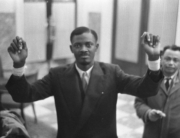
In 2020, how do you feel about a photo of a woman’s long legs and luscious ass sticking lazily out of a crocodile’s mouth? Welcome to the world of Helmut Newton. The celebrated photographer made his name starting in the 1970s with over-the-top tableaux that fused hard-edged 1930’s black-and-white styling to images of leggy, breasty models in modishly sadomasochistic action. In the 1980s, Newton refined his approach even further in celebrity portraiture that hypercharged the famous into sexed-up titanium cyborgs.
Helmut Newton: The Bad and the Beautiful tries to analyze Newton’s inspiration, and the exercise goes as deep as a model’s moisturized, burnished epidermis. But perhaps it’s not the filmmaker’s fault; one gets the sense that Newton never wanted to be deconstructed and always stayed out of reach.
Newton died in a 2004 car accident at age 83 and did not participate in the film, so director Gero von Boehm has assembled archival material and interviewed fashion world veterans to shape the portrait. The method lends itself to a glancing approach perfect for framing an artist who avows, “I’m interested in legs, breast, face…But soul, I don’t get that.”
Models like Grace Jones and ubiquitous Vogue editor Anna Wintour hold forth on Newton’s genius. The documentary’s smartest commentator, Isabella Rossellini, insightfully points out the struggle between contempt and desire in his work, which presents women as “powerful, beautiful, frightening, and repellent.” As Newton’s wife, June, states, “He will always be a naughty boy.”
Maybe Newton froze as a naughty boy at age 18, when his Jewish family fled Berlin before the start of World War II. Newton recalls a happy adolescence, but his mentor, photographer Madame Yva, died in one of Hitler’s concentration camps. The young Helmut settled in Australia, then roamed Paris, the United States, and the world. Along with a warped sense of fun, a Nazi-ish shadow of doomed heroism darkens much of Newton’s work—Rossellini observes “Helmut photographs women the way Leni Riefenstahl photographs men.” And a certain blasé detachment balances the visual drama. “Somehow I’m distant from everything that happens to me,” Newton says.
So fittingly, the photographer’s emotional life remains resolutely hidden. June provides little personal insight, sounding more like a publicist than a spouse. A welcome crackle of confrontation arises when Newton faces off against Susan Sontag on French television. Poised, cool as a drink of Evian, and speaking precise French, Sontag calls Newton’s oeuvre the way she sees it. “I find your work misogynistic, and I found it unpleasant.” “I love women,” protests Newton with a defensive smile. “I am not surprised,” responds Sontag. “A lot of misogynistic men say they adore women, but they show them in a humiliating way.”
Far from being insulting, Sontag seems animated by curiosity and a desire to get to the bottom of the contradictions that define Newton’s work. This stylish documentary would have benefited from a little more of that bracing spirit of inquiry, and maybe a reassessment of where Newton’s work fits in our current cultural moment. But hey, it’s fashion, and his photos still have the power to shock.






Leave A Comment